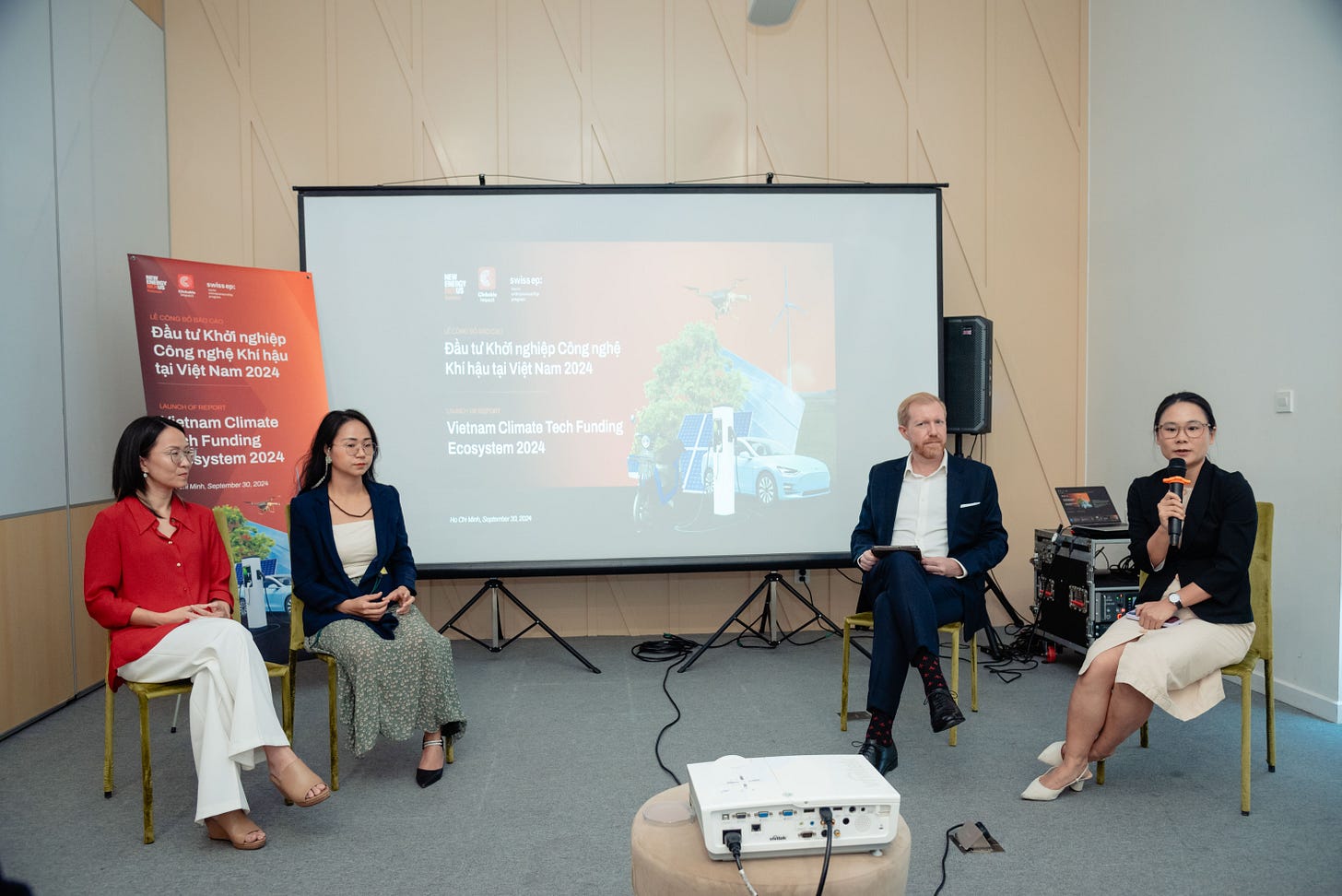Welcome back to Clickable Insights. Today’s newsletter discusses Clickable Impact’s first-of-its-kind report on Vietnam’s climate tech funding ecosystem. We also explore the massive gender gap in blended finance for renewable energy.
In other editions, you will find perspectives on agriculture, cleantech innovation, sustainable tourism, and green finance across Asia and the Pacific. Visit our Substack page to read editions by the topics most important to you.
If you’re reading Clickable Insights through a forwarded email, sign up below.

The State of Vietnam’s Climate Tech Funding Ecosystem
Clickable Impact took a big gamble. Along with our partners at New Energy Nexus, we saw an unmet need to map and benchmark climate tech funding in Vietnam.
Investors kept asking us, “Is there a list of fundable climate tech startups anywhere?” No, there wasn’t.
Startups would also ask us, “Is there a list of VCs and other sources of finance for Vietnamese climate tech startups?” No, there wasn’t.
We had a little roadshow for our idea, tried to raise some money to support it, succeeded in raising partial funding from our friends at the Swiss Entrepreneurship Program (Thanks, Swiss EP!), ran out of gas, and decided to forge ahead anyway.
Many person-days of research and an exhausting peer review process later, Vietnam’s first Climate Tech Funding Ecosystem Report is available for download.
Vietnam stands at a critical juncture: The country needs to navigate the twin goals of achieving high-income status by 2045 and reaching net-zero emissions by 2050.
Luckily, Vietnam’s rapid economic growth and vibrant entrepreneurial economy create a fertile ground for climate tech innovation. While funding for climate techs lags behind the rest of the world (4% of all startup funding in Vietnam vs 10% globally), it is growing fast: 365% year over year from 2021 to 2023.
Other report findings include:
Vietnam was home to 49 funded climate tech startups from 2015-2023
Funding came from 27 VCs
The total funding over the same period was US$92.6 million
The lion’s share of funding went to two sub-verticals: farming and food production (48.4%) and mobility (40%).
Only two climate tech startups have matured to Series B.
The report launch took place on Monday in Ho Chi Minh City with robust attendance from journalists and members of the climate tech ecosystem.
Download the report now.
Blended finance, renewable energy, and gender
A recent report from the Catalytic Climate Finance Facility took stock of blended finance at the intersection of gender and renewable energy – and the results are damning.
Overall:
Only 22% of all climate blended transactions are gender-responsive, with agriculture and energy being the dominant sectors for gender-responsive climate deals.
Women and girls are the intended direct beneficiaries of only 2% of all climate blended deals and end beneficiaries for 11% of these deals.
Women hold less than 11% of leadership roles in the renewable energy sector and only 32% of jobs in renewable energy globally, despite making up 48% of the global labor force. They are particularly underrepresented in technical positions (28%) and overrepresented in lower-wage administrative roles (45%).
This is all despite the fact that women are disproportionately impacted by climate change. According to UN Environment, 80% of the people displaced by climate change globally are women or girls facing heightened risks of poverty, violence, or unintended pregnancies as they migrate to safer locations.
A report from UN Women, meanwhile, estimates that by 2050, “climate change may push up to 158 million more women and girls into poverty and see 236 million more face food insecurity.”
So what can be done, at least within the global renewable energy value chain?
The Catalytic Climate Finance Facility authors highlight several opportunities within the gender gaps of this sector. For example, gender-responsive finance can provide career advancement and targeted recruiting opportunities for women, implement and monitor zero-tolerance policies and protocols for workplace discrimination and harassment; and consult communities and proactively design participatory sessions to promote the inclusion of women.
A gender-responsive energy transition framework is essential for safeguarding the rights of marginalized groups by tackling the root causes of gender inequality in the shift toward sustainable energy. This means addressing barriers faced by vulnerable groups throughout the energy value chain – as consumers, suppliers, and distributors – to ensure that the benefits of the transition from fossil fuels are equitably shared.
All of these steps and more are an absolute must when it comes to blended finance for renewable energy and beyond. Taking a step further, we also endorse the points of the COP28 Gender-Responsive Just Transitions and Climate Action Partnership.
The lessons learned from the energy transition highlight the importance of gender-sensitive planning and investment across all climate action efforts, especially in regions vulnerable to extreme weather events.
As the international community mobilizes to support recovery efforts in Southeast Asia following Typhoon Yagi, which killed over 700 people across Vietnam, Laos, Myanmar, and Thailand, the need for gender-responsive climate adaptation and disaster risk reduction is ever more pressing. It is crucial to center women and girls in these efforts – not only for immediate relief but also for investing in long-term strategies that foster sustainable and resilient livelihoods.
Clickable Insights is brought to you by Clickable Impact
Clickable Impact is an Asia-based consultancy committed to climate action and sustainable development. We have three practice areas: public affairs and communications, sustainable tourism, and transformative innovation. Across our work, Clickable Impact favors projects that urgently mobilize private sector engagement, policy action, and investment.
All views expressed in this newsletter are our own.
Copyright © 2024 Clickable Impact, All rights reserved. You are receiving this email because you opted in via our website.
Our mailing address is:
House 20A, 11/5 To Ngoc Van, Quang An, Tay Ho
Hanoi, Hanoi 11207
Vietnam



